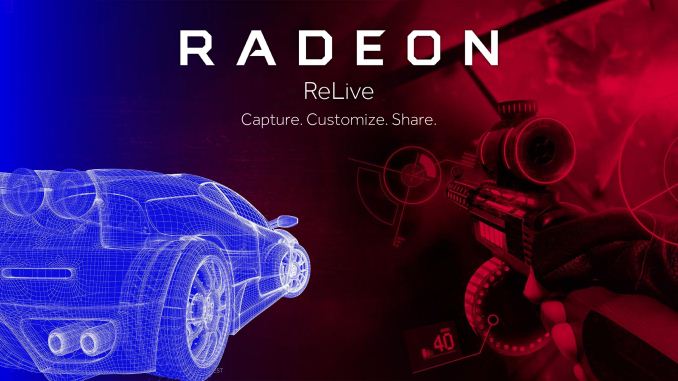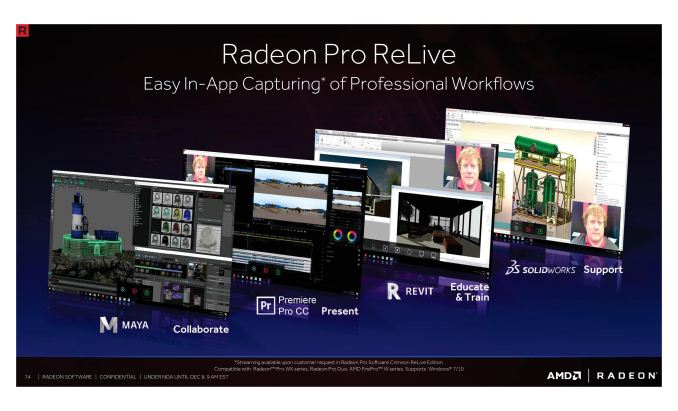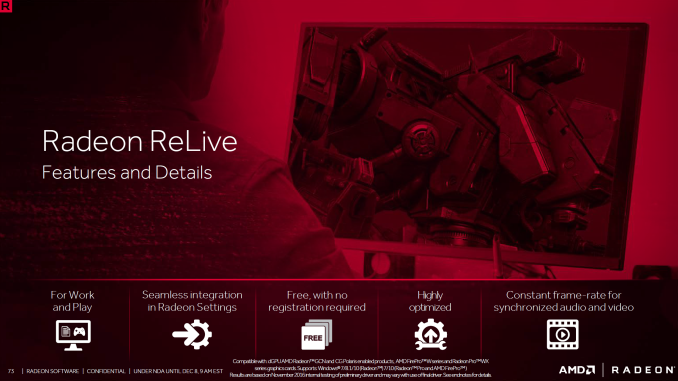AMD Delivers Crimson ReLive Drivers: Yearly Feature Update for Radeon Gamers and Professionals
by Ian Cutress on December 8, 2016 9:00 AM ESTReLive
The biggest part of the ReLive launch, despite the major amount of updates, fixes and new features, is actually the ‘ReLive’ itself, or ‘re-live’. Basically on our hands is an on-screen recording tool that implements integration to streaming services and offers options for professionals to demonstrate or promote with overlay and webcam features all while giving a minimal impact to performance.
So clearly there are plenty of gaming capture software suites already available on the market such as XSplit, individual webcam software, and even a Game DVR capture tool built directly into the latest editions of Windows 10. One of the key advantages AMD claims it has over all the others is that being a GPU manufacturer means they can interact with the hardware in ways the others cannot, leading to a much lower overhead and better experience than the rest. Also, it comes free with the driver software and doesn’t require a license.
Aside from the obvious game streaming aspect most users are familiar with, AMD is promoting ReLive as a professional tool as well, bundled with the requested versions of the Pro software set. The blurb from AMD states that using a tool such as ReLive can help with training and remote presenting, not to mention that AMD is also certifying the tool with commercial software packages as required.
ReLive will support direct streaming into many online video services such as YouTube and Twitch, as well as a gamut of popular Asian streaming websites (panda.tv, Douyu, Huya, Longzhu). Control for ReLive’s features will be via an in-app toolbar, offering instant replay of up to 20 minutes of onscreen footage and custom hotkey support for things like overlay images and webcam positioning.
Support for ReLive will be on all GCN enabled discrete graphics cards for Windows 7/8/10, and for Pro WX and FirePro W-series cards on Windows 7/10.














48 Comments
View All Comments
psychobriggsy - Friday, December 9, 2016 - link
AMD has been shipping proprietary AMDPRO drivers on Linux for quite some time, and if you want open source then AMD is the only choice really given Nvidia won't provide Pascal firmware images for Nouveau, and even then the AMD open source drivers are faster (in fact they compete very well with AMD's blobs on Linux now, they just don't provide OpenCL and Vulkan yet).Sure, if you game on Linux the Nvidia blobs are a bit faster than AMD overall, but it certainly isn't like a few years ago.
BrokenCrayons - Thursday, December 8, 2016 - link
Phrononix is my usual source for GPU benchmarks in Linux. I'm a regular reader over there and much of my current opinion was based on their performance analysis.YukaKun - Friday, December 9, 2016 - link
Benchmarks don't tell the day-to-day story. I have used both throughout the years and AMD has gotten ahead of the game now. People's complaints took some time, but they got their stuff together and they have zero things to have envy of nVidia's drivers.Performance not-withstanding, AMD is in a great shape now in the Linux world. In fact, I have to say it works wonders with SteamOS. Maybe I am a lucky one, but my 7970Ghz did not have a single issue playing all of the Linux ported titles and now the RX480 doesn't either. Outside of gaming, no issues either. It's been quiet sailing so far and I hope it remains that way.
I can't say the same thing with nVidia in my laptop. I still, after 10 years aprox, still don't have switchable graphics and I am scared of upgrading the proprietary binary, since I've had issues with it, even using genkernel.
Cheers!
BrokenCrayons - Friday, December 9, 2016 - link
Thanks for the information. I've been running a few older Nvidia GPUs (NVS 160m and 8400m GS) in my laptops without problems, but I don't use open source drivers. They experience has been very "sane" for my usage. I've yet to move my desktop with its GT 730 off Windows 7 which is largely a laziness thing as I already have an unused drive sitting in the case that just needs to be plugged in.I haven't personally tinkered with AMD graphics under Linux since I retired a couple of older laptops, one with a C-70 and another with an E-450 and their integrated GPUs. They were a pain to get working under Arch and Mint. I'm glad to hear that a current gen RX480 is working out for you. I might grab a RX460 in the next month or three and at that point I'll probably be more interested in transitioning to Linux and moving the system into a smaller case (microATX board in a full tower case...kinda a waste of space).
mr_tawan - Friday, December 9, 2016 - link
Bad news is, the latest AMD's RFC for DAL/DC get slammed today.psychobriggsy - Friday, December 9, 2016 - link
Yeah, I definitely sense that AMD's Linux devs were being held back by a higher up PHB regarding the HAL that was being imposed. Hopefully this major burn will allow them to do things properly at the kernel level even if it needs some linux-specific stuff in the drivers.IntoGraphics - Tuesday, January 3, 2017 - link
No.Read Phoronix for "It Looks Like AMDGPU DC (DAL) Will Not Be Accepted In The Linux Kernel" :
http://www.phoronix.com/scan.php?page=news_item&am...
VisS - Friday, December 9, 2016 - link
What Crap ?Colin1497 - Thursday, December 8, 2016 - link
Out of the box this looks really impressive. Time to start the download.One question: Technical reason that rebadged r9-2xx series cards get HDR10 in their r9-3xx guise while the original r9-2xx's don't? BIOS or marketing?
Colin1497 - Thursday, December 8, 2016 - link
Just realized how old I sound saying "start the download" like this was 1993 and it was going to take a week. It took a few seconds...